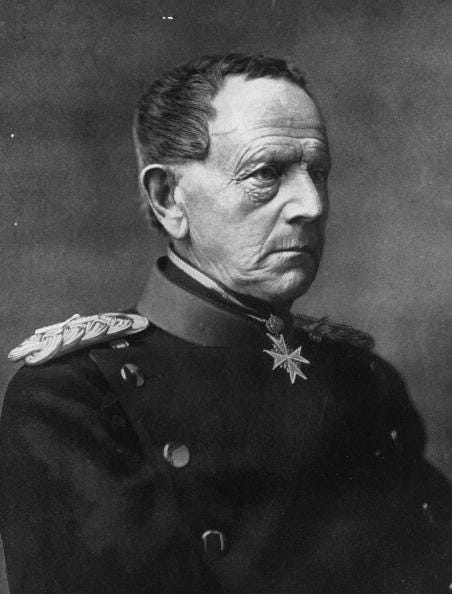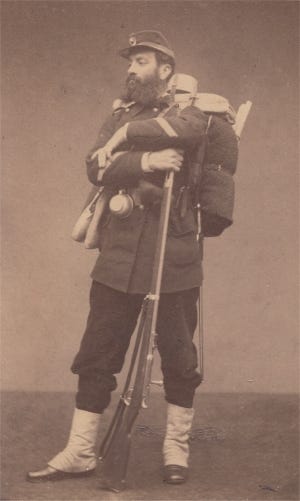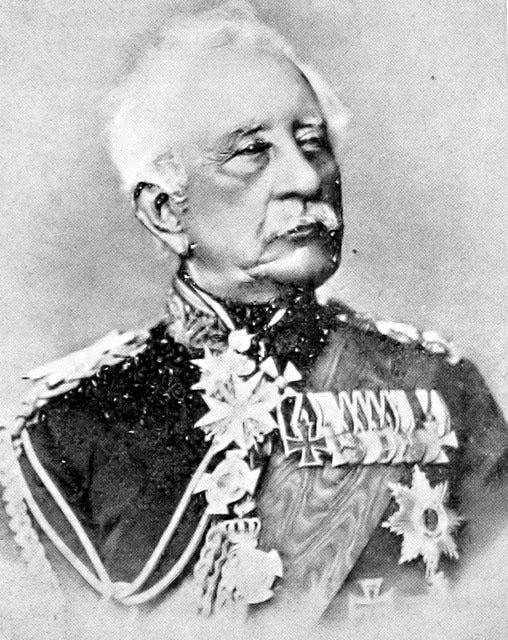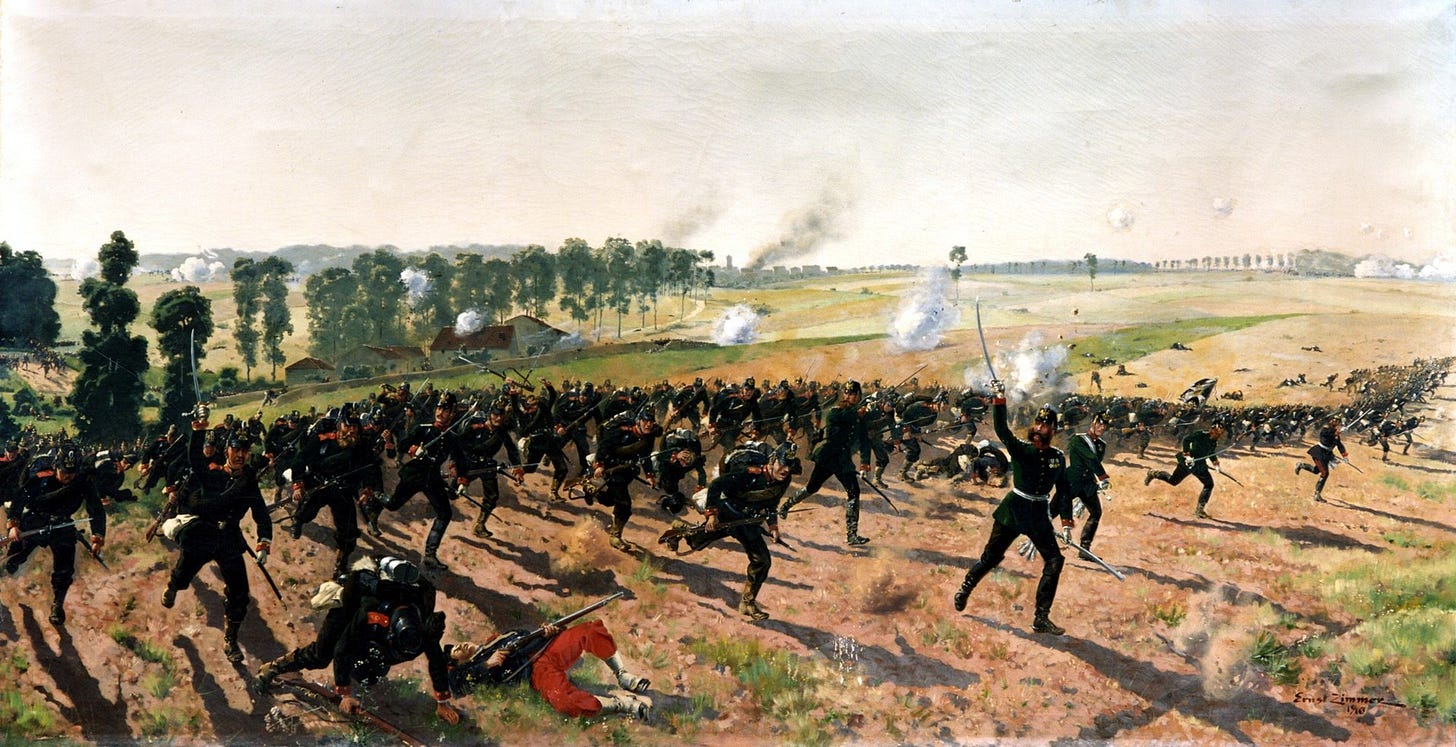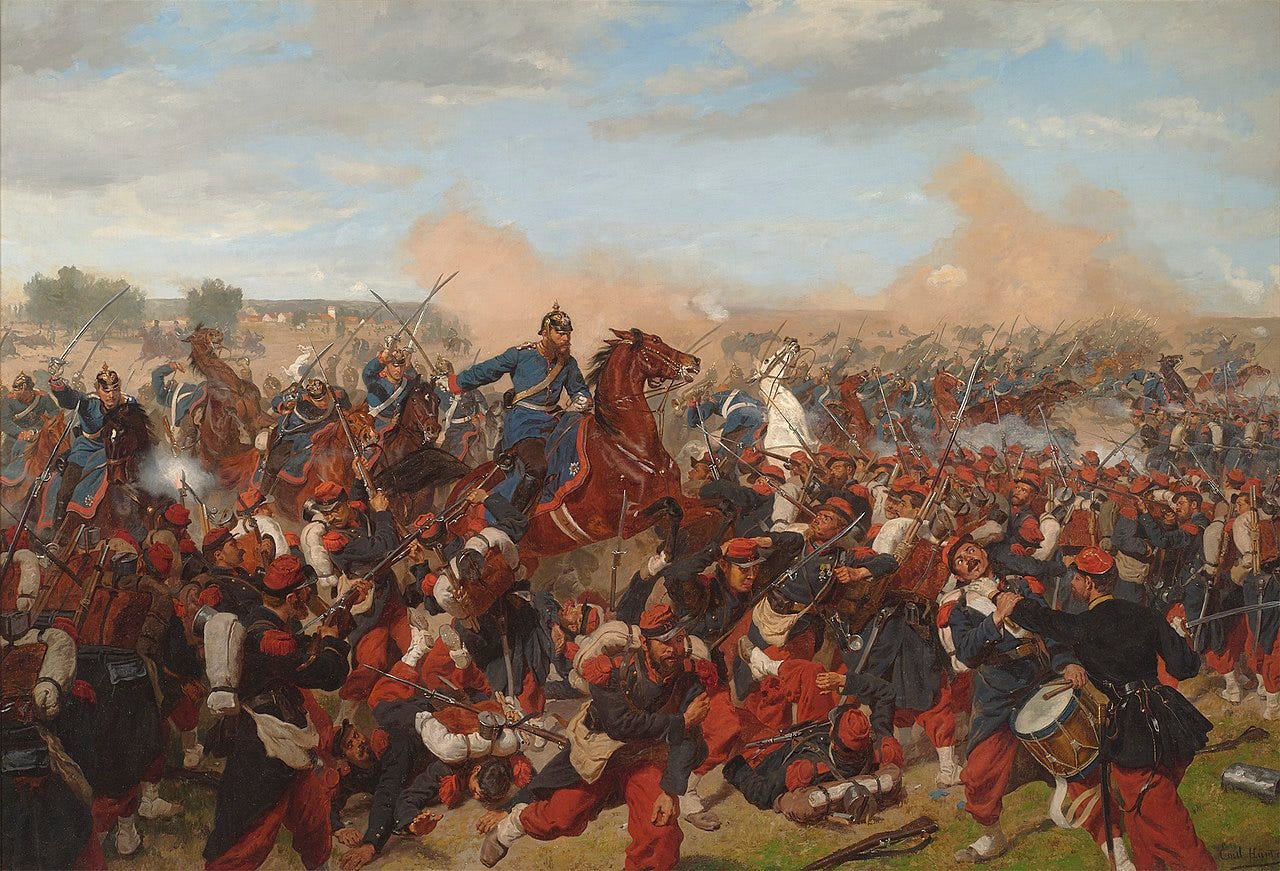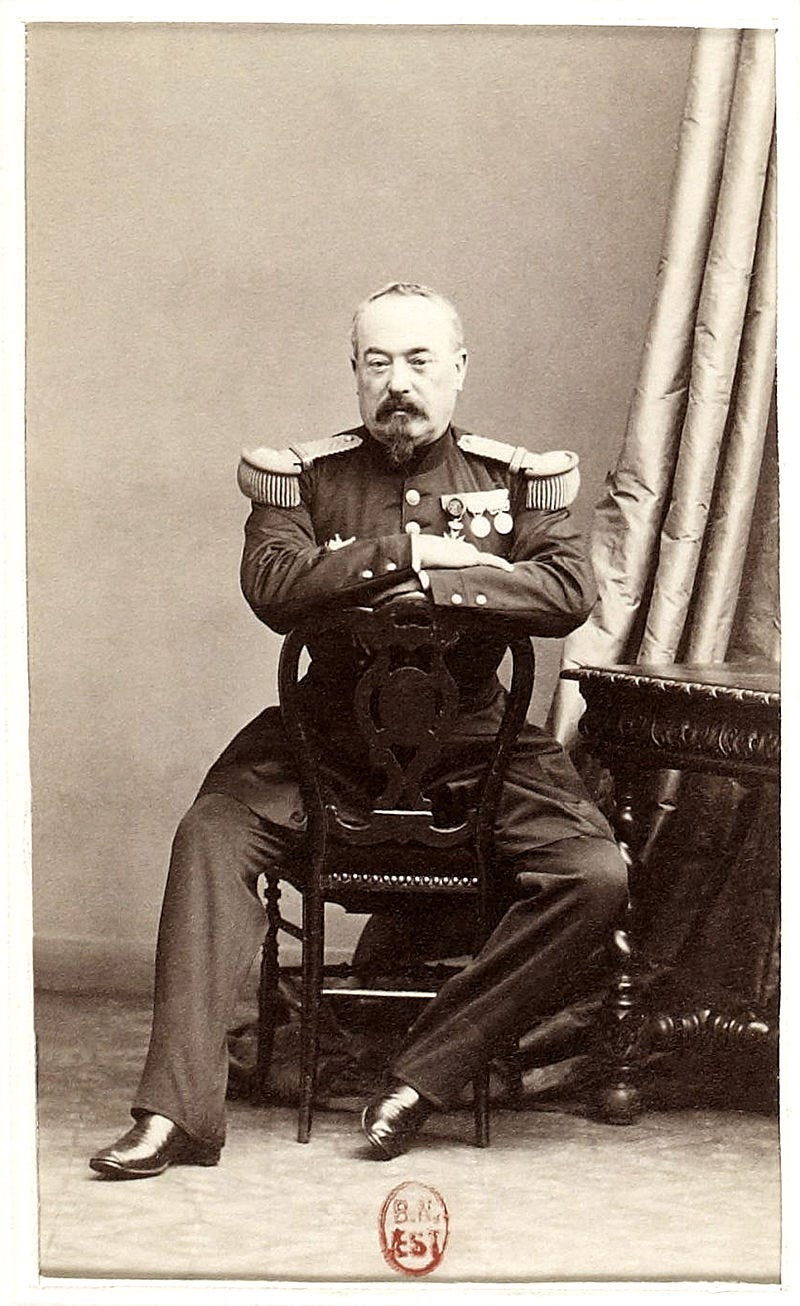The Moltke Mirage
The History of Battle: Maneuver, Part 7
No country dominated both the practice and theory of warfare in the 19th Century like Prussia. The century between the fall of Napoleon and the beginning of the Great War was, in many ways, a sort of classical era or golden age for the Prussian military establishment. This was the era in which Prussia fought a series of tremendously successful wars, decisively defeating the two powerful neighbors - Austria and France - who had traditionally been the check on her power. In doing so, the Prussian minister Otto von Bismarck at last solved the “German Question” and achieved the unification of Germany under Prussian leadership. This created the embryo of the German superpower that would torment Europe in the 20th Century - a state whose formidable powers were based on marrying the industrial potential of a united Germany with the military prowess of the Prussian army.
This golden age of the Prussian military was dominated, above all, by Helmuth von Moltke. Amid a tradition which produced many of the most famed commanders in history - Frederick the Great, Blucher, Ludendorff, Manstein, Guderian, Rommel - Moltke in many ways stands apart and above the rest. He was certainly the most successful - decisively winning all of his wars and reestablishing Prussia’s reputation as the preeminent military in Europe.
Moltke’s thirty years as Chief of the Prussian General Staff correspond to the greatest heights of Prussian military success and the ascent of Prussia to the apex of the geopolitical food chain. While great credit is given (and rightfully so) to Prussia’s master statesman, the “Iron Chancellor” - Bismarck himself was not shy about the fact that Prussia’s fortunes were ultimately tied to the success of the army in battle - what he called “the iron dice”. In one of his most famous and endlessly quotable speeches, he said:
“The position of Prussia in Germany will not be determined by its liberalism but by its power… Prussia must concentrate its strength and hold it for the favorable moment, which has already come and gone several times. Since the treaties of Vienna, our frontiers have been ill-designed for a healthy body politic. Not through speeches and majority decisions will the great questions of the day be decided—that was the great mistake of 1848 and 1849—but by iron and blood.”
Iron and blood were Moltke’s domain, and for thirty years he embodied Prussian military acumen and destroyed every army that opposed him. It was indeed the apogee of the Prussian Army.
And yet.
In an unbroken sequence of glorious Prussian victories, the discerning eye could see the horrors of the Great War looming. Despite Moltke’s artful handling of his armies and the stunning results on the strategic level, there were unsettling developments on the ground. Casualty rates among attacking infantry units were disturbingly high. Command and control frequently became something of a snarl. The army was consistently forced to lean on massed artillery to break open enemy positions.
Moltke was without a doubt an eminently skilled commander, and his battlefield successes had titanic ramifications. His admirers could certainly have persuaded themselves that the great Moltke had proven that Prussia could successfully prosecute its classically fluid and aggressive brand of maneuver warfare, with bold and sweeping offensive operations designed to crush the enemy army. Molkte, it could be said, had brought Frederick the Great’s aggressive operational elan into the modern era - combining Prussia’s ancestral attacking spirit with railroads, the telegraph, and explosive shells.
It was, sadly, a mirage. Moltke’s sublime skills notwithstanding, the technological changes of the age were moving warfare indelibly towards the horrific conclusion of the Western Front. The trenches, barbed wire, endless artillery barrages, and mass casualties were not an aberration, but the most logical (some might even say inevitable) outcome of industrialized war, given the particular set of technologies that emerged in the 19th century. Indeed, the grinding attrition of Verdun and the Somme could be clearly seen in Moltke’s wars, looming on the horizon. It was the brilliance of this man that he could transcend this gory attrition, if only for a little while.
Soul Searching
Moltke dominated the Prussian military establishment at a time when armies were still groping their way forward into the age of industrial war. Armies were becoming ever larger and wielding ever more powerful weaponry. The size of these armies increasingly made it impossible for campaigns to be improvised the way Napoleon did. Successfully making war required filing cabinets full of railway timetables, maps, and statistical analyses - a level of detail and micromanagement which offended many traditionalists, who still viewed war as an “art” that should be conducted according to the instincts of field commanders.
For Prussia, in particular, this new era of increasingly bureaucratized war seemed problematic, because Prussian commanders were conditioned to fight with a preternatural level of aggression and attacking energy. Blucher, the hero of the Napoleonic Wars, was the platonic ideal of the Prussian commander. Nicknamed Marschall Vorwärts - “Marshal Forward” - by his men due to his battlefield aggression, Blucher was not a particularly sophisticated operational practitioner. His “operational art”, as such, consisted of finding the enemy army and attacking it as quickly as possible.
For Molkte, the challenge was merging and creating some level of synergy among these two diametrically opposed notions of command - calculation and rational planning, and the instinctual aggression of field commanders who wanted simply to march to the enemy at top speed and attack him. Institutionally, this tension was represented by the difference between the staff officers - command and control functionaries who provided the planning, analysis, intelligence, and communications expertise which allows modern armies to function - and the commander - a man who instantiates action and aggression.
In a more metaphysical sense, the same tension was presented by Clausewitz in his model of warfare as a tension between opposing forces. These forces, according to Clausewitz, were rational planning, violent emotion, and random luck. War, according to Clausewitz, was always subject to each of these forces to some extent. While luck cannot be controlled, a well run army would seek to balance between rational strategy (the staff officers) and emotive aggression (the field commander).
Moltke, perhaps as well as any commander in history, successfully mediated these forces because he perfectly well understood that both had their role in a successful campaign. He understood perfectly well that war had become far too complex to wage spontaneously, on the basis of instinct and improvisation, and dutifully nurtured a suitably robust planning apparatus and an army nervous system packed with highly trained staff officers. Nevertheless, even as Chief of the General Staff, Moltke was never overly wedded to obsessive planning. He famously quipped that “no plan survives contact with the enemy’s main body”, and was adamant that overly detailed and rigid planning could be fatal. He accordingly tried to keep his own plans and orders acceptably vague and generalized:
“One does well to order no more than is absolutely necessary and to avoid planning beyond the situations one can foresee. These change very rapidly in war. Seldom will orders that anticipate far in advance and in detail succeed completely to execution.”
Moltke viewed his role as that of a mediator between planning, luck, and aggression. His task was not exactly to control armies in the field, only to steer them - bending them, sometimes with great difficulty - to follow a general maneuver scheme and react in a timely manner to the enemy’s movements. His campaign in the Austro-Prussian War was a classic example of this. Moltke’s operational plan was rather vague. Moltke very generally planned to disperse his armies and draw them together around the Austrian army, but he had no strict notions about where the Austrian army might be or where it would be brought to battle. The “plan”, as such, was more of a sketch or an outline, which was only given full substance once the campaign began.
One campaign above all highlights all of these issues - the tension between planning and aggressive instinct, Moltke’s own preternatural gifts, and the growing bloodiness of offensive warfare. This campaign was Moltke’s last, and his greatest: the Franco-Prussian War of 1870. A war of great mistakes and great violence, which Moltke bent to his will to forge a great victory.
The Prussian Army Always Attacks
Prussia’s war with France began with a few classic Moltke motifs. Moltke was a great proponent of the railroad as a tool for rapidly mobilizing and concentrating armies for action, and sure enough the run up to war saw Prussia concentrating three massive field armies on the French border - quickly assembling them using the prodigious internal German railway system. The war was, if we are being technical, more of a Franco-German War, as Prussia enjoyed the support of several of the smaller German states, especially Bavaria. However, the war is known as the Franco-Prussian War, and the Prussians - in particular Moltke - ran the show.
The second classic Moltke motif was the suitably ambiguous nature of Moltke’s initial operational scheme. As in the case of the Austrian war, he put out a mere sketch or framework for the operation. Three armies (from northwest to southeast, so that 1st Army was the furthest to the northwest and 3rd Army was on the bottom) would advance into France on a sort of southeasterly axis, winding their way towards the French field army. Moltke’s idea was probably something similar to the Austrian campaign - whichever army found the French first should attack and pin them in place while the other armies converged to smash them.
If this was Moltke’s plan, the ensuing debacle highlights the complexity of war, and would surely have Clausewitz nodding his head sympathetically. The entire Prussian scheme very nearly came apart, due to two complicating factors - the instinctive aggression of Moltke’s field commanders, and the fact that the French also had a say in the progression of the war.
The French suffered from a variety of deficiencies in this particular war. Their commanders were, by and large, incompetents, and they were hamstrung by the on and off meddling of the Emperor, Napoleon III (named after his more famous and competent uncle). This lesser Napoleon never really felt politically secure, and decided that he would stiffen French opinion of his fighting quality by ordering an attack. Thus the war strangely began with the main French field army, the Army of the Rhine, attacking eastward into Germany without a clear objective. Their goal, as such, was simply to attack so that Napoleon could tell Parisians that he had attacked.
The French initially moved towards the town of Saarbrücken, thinking that they could get the jump on Prussian mobilization and strike a blow before the Prussians were ready. To their surprise, they discovered that three Prussian field armies were already mobilized and in the theater. The speed of Prussian deployment was surprising, because France’s own mobilization system was archaic and lethargic. Lacking a coordinated railway mobilization plan, French troops had to compete with civilians for train tickets, or else walk to their bases. Prussia’s hyper-efficient deployment therefore took the French aback, and forced them to scuttle their opening offensive and withdraw back into French Lorraine.
The French attack was brief, but sufficient to create irritating complications. In the first action of the war, a French platoon bumped into and routed an entire Prussian company. This was Prussia’s first introduction to France’s Chassepot rifle. Unlike in the Austrian war, where the Prussian needle gun had been the superior infantry weapon, the French wielded the bolt-action Chassepot which outclassed the needle gun in every way - accuracy, firepower, and especially range. In that first little discovery skirmish, a platoon of less than 50 French riflemen managed to shred and rout a 200-strong Prussian company.
The superiority of the Chassepot would become Prussia’s main tactical problem in this war. There was, however, a bigger problem. An operational problem.
The French made a bumbling, groping move into Germany, fighting with variegated Prussian and Bavarian units around Saarbrucken, then inexplicably withdrew back into France. The French offensive had never really been thought out, and Napoleon III evidently felt he’d done enough to satisfy domestic audiences (newspapers in Paris spoke of a great victory), so it was time to pull back. Prussian commanders watched this with a mixture of confusion and bemusement.
Moltke now ran into one of his most obstinate problems: the aggression of his field commanders. His plan was for the three armies to concentrically converge on French Army of the Rhine, hopefully trapping and destroying it. The 1st Army, at the north of the line, was intended to move on a southwestwardly basis to come down on the northern flank of the French force. However, the commander of the 1st Army, General Karl von Steinmetz, thought that this was silly. He was a classically Prussian commander who only wanted to attack as quickly as possible. He therefore decided to instead move his army directly to the south, on the direct route to the French main force.
Steinmetz’s logic was fairly straightforward - the French, as he saw it, were trying to slip away, and so somebody needed to act decisively to grab hold of them and keep contact. Therefore, he moved as fast as he could to do so himself. The problem with Steinmetz moving south was that it carried him directly into the marching path of Prussia’s 2nd Army. Remarkably, Steinmetz’s 1st Army actually marched directly onto the roads reserved for the 2nd Army and severed the 2nd from its forward units. This not only obstructed the 2nd (the largest of the three Prussian field armies, and the schwerpunkt of the operation) but also threatened to create a colossal traffic jam as the two armies’ massive supply trains (miles upon miles of horse drawn carts) turned into a snarl.
Let us allow historian Geoffery Wawro to succinctly describe this bizarre and potentially catastrophic incident:
Thus began a ludicrus episode in the Franco-Prussian war: the smallest of the three armies, never intended to play more than a supporting role, blocked the principal army’s way forward and ventured off to do battle with 60,000, potentially 120,000 French troops. To Moltke’s amazement, Steinmetz was risking a large fraction of the Prussian army and ruining the attempted Kesselschlacht [encirclement] on the Saar.
A Major in Moltke’s staff made a measured remark in his diary that “Headquarters is beginning to regret Steinmetz’s appointment.” One can only imagine the swearing from Moltke and his team - surely there was a great deal of scheisse in the air. As for Prince Friedrich Karl - the commander of the 2nd Army, who now had to wait in agony for Steinmetz to get out his way - he was apoplectic, and allegedly wept that “Steinmetz has ruined my beautiful plans.”
With the chance at a clean, cohesive maneuver wrecked by Steinmetz’s imprudent move directly into 2nd Army’s line of advance, the first week of the war collapsed into a series of disjointed, but nearly identical discovery battles on the frontier. These battles elucidated the emerging pattern of this war.
Prussian units would veritably bump into the French, and their commanders would eagerly launch an attack without having a good sense of the French disposition or strength. Prussian commanders would hurl their entire unit into the attack without knowing whether they were facing a French brigade, division, or even a whole corps. As a result, the Prussians usually started the day badly outnumbered and ended it with the situation reversed, as more and more Prussian units spilled onto the field.
At Worth, for example, General Hugo von Kirchbach threw his 10th Division in against the entire French 1st Corps (containing no less than 5 divisions). Casualties were enormous on the Prussian side thanks to the exorbitant range of the French Chassepot rifles; Prussian infantry were shredded from what they considered to be impossible distances. However, the battle slowly turned against the French as that single Prussian division turned into a whole corps, and eventually four corps, which poured artillery fire on the French and forced a withdrawal. This had a quintessentially Napoleonic quality to it - the first unit on the scene attacks, and every other unit in the vicinity marches at high speed to join the fight, creating a battle that swells in size throughout the day.
The frontier battles fought in the first week of the war were something of a mixed bag. Moltke was deprived of a single decisive battle, as he had wished, but he did succeed in mauling several French corps - in the wake of their withdrawal, the door into France was open. Tactically, these frontier engagements had revealed that the Chassepot gave the French a disturbing firepower advantage. French rifle fire was effective at 1000 yards, while the Prussian needle guns could scarcely achieve half that. This problem could only be counteracted by massing Prussia’s superior artillery - steel, breach loading Krupp guns that hilariously outclassed France’s aging bronze artillery arsenal. This odd technological disjoint created a unique tactical incongruity, which resulted in the vast majority of Prussian casualties (upwards of 70%) being inflicted by rifle fire, while artillery did most of the damage against the French. After-battle casualty reports from the French noted that nearly two thirds of those wounded or killed by artillery were hit in the back - implying that they were laying face down, trying to shelter from the barrage when they were struck.
With the first week providing inconclusive results, the war entered a brief lull as the French withdrew to lick their wounds, and the Prussians sorted themselves back out into marching columns to resume the plunge into France. It was at this point that Prussia’s true advantage became manifest - decisiveness.
The French had two main field bodies at this point. The main mass of the Army of the Rhine under Marshal François Achille Bazaine had consolidated and anchored itself on the fortress at Metz, while the 1st Corps under Marshal Patrice MacMahon, which was chewed up after its action on the frontier, had withdrawn deper into the French interior. French command wasted an entire week in indecision. Eventually, MacMahon’s corps retired west to Chalons, where it was designated to be reinforced and become the foundation of a new “Army of Chalons”, while the Army of the Rhine was inexplicably allowed to sit idly at Metz, doing absolutely nothing.
This was a curious moment. The correct thing for the French to do at this point was to more or less write off Metz and the entire eastern rimland, pull the Army of the Rhine back to the west and anchor it either on Chalons, Riems, or Paris, where it could receive reinforcements, sensibly defend from behind a river, and stabilize its supply lines. Moltke could hardly believe that the French would let 160,000 men simply sit in such an exposed position, but it was good luck that they had. All the intelligence suggested that Bazaine and his enormous force were, in fact, simply parked at Metz. Moltke quickly ordered the entire army to turn as fast as they could and converge on Metz - but as they rushed to the scene, on August 15, Bazaine finally, at long last, began to stir his army to withdraw from Metz and retreat towards the west. The Prussians were too late.
But not entirely. One Prussian Corps - the III Corps, of 2nd Army - was within range. Operating on typically vague intelligence, the commander of III Corps, General Constantine von Alvensleben, observed French columns moving away from Metz towards the west. Presuming that this was merely the French rearguard (he rationally assumed that the French could not possibly have only just begun their retreat), he ordered an attack at once. In fact, III Corps had not bumped into the French rearguard, but the main body of the enormous Army of the Rhine.
Thus began one of the strangest battles of the war, and indeed of the modern era. A single Prussian corps, with no solid sense of the enemy’s strength and location, animated only by the instinctive attacking spirit of its commander, launched an attack on an entire French field army. Alvensleben had naught but two infantry divisions in his command, and here he was beginning a battle against a French army that had no fewer than sixteen divisions in the immediate vicinity. As if to underscore the disparity, Alvensleben began the battle by flinging his 5th Infantry Division directly at the enemy, inadvertently attacking the three division strong French II Corps. One division against three; a single corps against five. This was the Battle of Mars-la-Tour.
Bazaine had a real chance to completely crush a Prussian corps and then resume his withdraw to the west. Instead, he exhibited the same passivity and inactivity that had led him to sit idly at Metz for an entire week. Alvensleben’s two infantry divisions - being generous, a combined 30,000 men - both attacked, each one ramming into an entire French corps. Bazaine had at least 120,000 men at his disposal - two of his corps (III and IV) were not even engaged. It would have been trivially easy for the French to launch a counterattack and annihilate the lonely Prussian corps. Instead, the French were content to simply sit in their positions and shoot back at the attacking Prussians. Their rifle fire, as ever, was murderously effective, but they squandered an ideal opportunity. The spectacle of an entire army sitting in a defensive stance against a single corps would come to haunt the French soon.
Alvensleben and his stoic divisions managed to hold on for most of the day, until the timely arrival of X Corps - the closest Prussian unit when the day began - managed to provide some modicum of stability. But even so, the passivity of the French was inexcusable, and they wasted a golden opportunity.
Mars-la-Tour was an extremely bloody battle. Both sides took something like 15,000 casualties - again, French rifles and Prussian artillery doing the most damage. It was, however, an unmitigated disaster for France. At the end of the day, Bazaine withdrew back to the fortress at Metz. Alvensleben had acted in the purest sort of Prussian tradition, impetuously attacking a force at least four times larger than his own, but in doing so (with the help of Bazaine’s complacency and lethargy) he had disrupted the French retreat to the west and created the time needed for the remainder of the army to arrive.
After fighting the bloody battle of Mars-la-Tour on August 16 and withdrawing to Metz, the French now had to fight what was more or less a rematch two days later - only this time, instead of facing only the Prussian III Corps, Bazaine would have to face the combined mass of Prussia’s 1st and 2nd Armies, which arrived in full during the intervening period.
Needless to say, Bazaine’s decision to retire back into Metz has been roundly criticized. The absolute priority had to be extracting his army to the west - to save it from being trapped, but the Marshal, for reasons that remain unclear even to this day, remained lethargic, uncertain, and - dare we even say - afraid. Some of his subordinates would later even accuse him of treason. He certainly had ample opportunities to leave Metz. He had an entire week (roughly from August 8-15) in which he could have withdrawn without a fight, then after Mars-la-Tour on the 16th he could have withdrawn westward toward Verdun, rather than going back into the Metz fortress. Even as late as the 17th, with the Prussians closing in, the road to Sedan to the northwest was wide open. Instead, he simply sat, uselessly, pathetically, hiding under the protection of the Metz fortress, until 180,000 Prussians had arrived on his doorstep.
The situation was seemingly clear to everyone except the Bazaine, who has marveled both contemporaries and historians with his utter inadequacy for command. Moltke, for his part, could not believe that the French were languishing at Metz for so long. The Austrian military attaché in Paris reported to his superiors in Vienna that “France can win only if Bazaine avoids decisive battle in Lorraine [Metz] and retreats to Paris.” The British attaché in France agreed, and wrote that “The importance of the French being able to concentrate at Chalons is enormous… if Bazaine is cut off, it would be a regular disaster, for there would be no force left to rally round, and nothing could then stop the march of the Prussians on Paris.”
Everyone understood except Bazaine. So, he found himself on August 18 fighting another battle on virtually the exact same ground where Mars-la-Tour had been fought two days earlier, this time against the mass of the Prussian 1st and 2nd Armies. This rematch is called the Battle of Gravelotte, after a village a mere 6 miles east of Mars la Tour.
Gravelotte was horrific. It pitted parallel, symmetrical lines against each other. Five Prussian corps against five French corps; 200,000 Prussians supported by 730 artillery pieces against 160,000 French with their 520 cannon. Moltke began with a notion of some sort of pinning and flanking maneuver, but the battle quickly devolved into brutal frontal assaults. The impetuous aggression of Prussia’s field commanders once again resulted in costly attacks in the face of deadly Chassepot fire, but once again Prussia’s superior artillery helped to even the odds. Some 270 Prussian guns were hauled up into a massive battery, which fired over 20,000 shells at the center of the French line. All the familiar motifs were there, and even some familiar characters. In fact, Moltke’s plan for a flanking maneuver broke down almost instantly because none other than General Steinmetz (who else?) ignored Moltke’s instructions and launched a frontal attack almost immediately, like an attack dog with a broken leash.
Gravelotte was artless, brutal, and ugly. I shall not even bother to map it, as a diagram would simply insult the intelligence of my readers. Simply picture two giant rectangles colliding. The Prussians came out rather the worse for wear, suffering 20,000 casualties against perhaps 13,000 French losses, but in the end concentrated artillery fire and persistent attacks managed to crack a hole in the French line, which forced Bazaine to retreat - yet again - into Metz. One French officer ruefully described the battle thusly:
We were the superior infantry, but that made no difference, for throughout we were just cannon meat for the Prussian batteries.
Indeed.
Murderously effective Chassepot fire had certainly done its part, and the Prussians paid dearly for the battle. Among their casualties were nearly 50% of the elite Guards Corps. In fact, upon learning of the damage done to his beloved Guards (where many of his cousins had become casualties serving as officers), King Wilhelm lamented what he believed to be a defeat and initially refused to believe it when Moltke told him that the battle had been a success. In fact, they had won the war.
Bazaine’s army was bloodied but intact. The larger problem, however, was that they had nowhere to go. Having retreated yet again into the fortress of Metz, they were now trapped. Those 20,000 Prussian casualties had been the price to block the French line of retreat and bottle up the Army of the Rhine for good. Bazaine and his army would spend the rest of their war besieged within Metz - a fortress with barely enough supplies to last a month. In fact, Metz was decidedly understocked on both food, rifle ammunition, and artillery shells. This fact made Bazaine’s conduct of the campaign all the more confusing - given the parlous state of the Metz supply depots, the fortress obviously threatened to be a trap rather than an indominable stronghold.
Tasked with the command of France’s primary field army, Bazaine had accomplished exactly nothing - he sat idly during the crucial weeks of the war as the Prussians moved in on him, then made a lethargic, half-hearted attempt to withdraw to the west, allowing himself to be blocked by a single Prussian corps. Then at Gravelotte, he traded blood with the Prussians and retreated yet again into his fortress to fester. On October 27, after exactly 39 days under siege, Bazaine would surrender along with his remaining 150,000 men.
For Moltke, the opening campaign had been an adventure, equal parts exhilarating, frustrating, and fortuitous. His comments about the impossibility of accurately planning out an entire operation were strongly prescient, as the unlikely and unpredictable decisions of both his own field commanders and the enemy threw the entire campaign into chaos. First came the questionable French decision to launch a half-hearted attack at the opening bell for propaganda purposes - this offered up much of the French field army in a vulnerable position. An attempt to capitalize then came off the rails due to Steinmetz’s unfortunate choice to march his forces directly into the path of 2nd Army, jamming up the Prussian advance. Stymied by Steinmetz, Moltke was then given a second chance to bag the Army of the Rhine when Bazaine decided to lay at Metz like a weak willed slug, marinating in his own indecision.
All the complicating elements were at play here. Moltke had to contend with confounding decisions by both the enemy and his own subordinates, all layered in the uncertainty and confusion of command and control in the 19th century. Yet he managed, just barely, to bend the battlefield to his will. Desperately wheeling the army as quickly as he could towards Metz, he succeeded - with the help of Bazaine’s spineless wavering - in trapping the French in the fortress and bottling up France’s main field army after only a few weeks of campaigning.
Above all, this opening campaign illustrated the deep tension undergirding this increasingly modern way of war. Moltke vs Steinmetz; rational planning vs violent emotion; the best laid plans of the general staff vs the instinctive aggression of field commanders who wanted to attack anything in their path. Even more disturbingly, however, the Chassepot had begun to raise questions about the efficacy of attacking at all. Entire battalions were shredded by French rifle fire, and it was only the might of those wonderful Krupp howitzers that was able to equalize things. For a Prussian army that lived and died by the attack, this was troubling indeed.
For the time being, however, Moltke - with generous help from Bazaine and Krupp - was still able to make the whole thing hum. His field commanders remained committed to the preternatural aggression of their forebears - keeping in mind that simple adage of Frederick the Great: “The Prussian army always attacks.” That remained as true as ever, with commanders at the division, corps, and army level all eagerly throwing themselves at French units far above their weight class. Moltke was never able to constrain this impulse - but he could steer it on the operational level and exert just enough control over it to win decisive victories, proving that Prussia’s hyper-aggressive style was still in business.
Unfortunately for France, Napoleon III was determined to prove that the French Army was still in business too.
Kesselschlacht
Keep reading with a 7-day free trial
Subscribe to Big Serge Thought to keep reading this post and get 7 days of free access to the full post archives.


